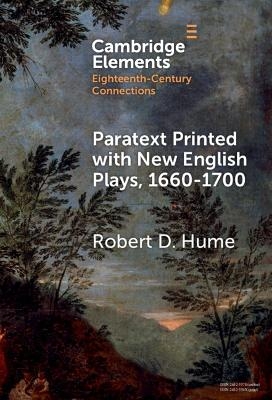
Paratext Printed with New English Plays, 1660–1700
Seiten
2024
Cambridge University Press (Verlag)
978-1-009-45412-4 (ISBN)
Cambridge University Press (Verlag)
978-1-009-45412-4 (ISBN)
This Element has a lot to tell us about what playwrights were attempting to do and how audiences responded, thereby contributing substantially to our understanding of larger patterns of generic evolution across the seventeenth and the eighteenth centuries. This title is also available as Open Access on Cambridge Core.
This Element Paratext printed with new English plays has a lot to tell us about what playwrights were attempting to do and how audiences responded, thereby contributing substantially to our understanding of larger patterns of generic evolution across two centuries. The presence (or absence) of twelve elements needs to be systematically surveyed. (1) Attribution of authorship; (2) generic designation; (3) performance auspices; (4) government license authorizing publication; (5) dedication; (6) prefaces of various sorts; (7a-b-c) list of characters (three types); (8) actors' names (sometimes with descriptive characterizations-very helpful for deducing intended authorial interpretation); (9) location of action; (10) prologue and epilogue for first production. Surveying these results, we can see that much of the generic evolution traceable in the later seventeenth century gets undone during the eighteenth-a reversal largely attributable to the Licensing Act of 1737. This title is also available as Open Access on Cambridge Core.
This Element Paratext printed with new English plays has a lot to tell us about what playwrights were attempting to do and how audiences responded, thereby contributing substantially to our understanding of larger patterns of generic evolution across two centuries. The presence (or absence) of twelve elements needs to be systematically surveyed. (1) Attribution of authorship; (2) generic designation; (3) performance auspices; (4) government license authorizing publication; (5) dedication; (6) prefaces of various sorts; (7a-b-c) list of characters (three types); (8) actors' names (sometimes with descriptive characterizations-very helpful for deducing intended authorial interpretation); (9) location of action; (10) prologue and epilogue for first production. Surveying these results, we can see that much of the generic evolution traceable in the later seventeenth century gets undone during the eighteenth-a reversal largely attributable to the Licensing Act of 1737. This title is also available as Open Access on Cambridge Core.
1. The twelve paratextual elements; 2. Background; 3. Ten varieties of paratext and two subsets; 4. Observations, reflections, and questions; 5. Overview: the big picture 1590–1800; Appendix A: cumulative statistics by decade and in toto; Appendix B: twelve varieties of paratext in 377 new English printed plays, 1660–1700; Bibliography.
| Erscheinungsdatum | 23.01.2024 |
|---|---|
| Reihe/Serie | Elements in Eighteenth-Century Connections |
| Zusatzinfo | Worked examples or Exercises |
| Verlagsort | Cambridge |
| Sprache | englisch |
| Maße | 152 x 229 mm |
| Gewicht | 271 g |
| Themenwelt | Kunst / Musik / Theater ► Theater / Ballett |
| Geisteswissenschaften ► Sprach- / Literaturwissenschaft ► Anglistik / Amerikanistik | |
| Geisteswissenschaften ► Sprach- / Literaturwissenschaft ► Literaturgeschichte | |
| Geisteswissenschaften ► Sprach- / Literaturwissenschaft ► Literaturwissenschaft | |
| ISBN-10 | 1-009-45412-9 / 1009454129 |
| ISBN-13 | 978-1-009-45412-4 / 9781009454124 |
| Zustand | Neuware |
| Haben Sie eine Frage zum Produkt? |
Mehr entdecken
aus dem Bereich
aus dem Bereich
Poetik eines sozialen Urteils
Buch | Hardcover (2023)
De Gruyter (Verlag)
CHF 83,90
Buch | Softcover (2024)
belleville (Verlag)
CHF 27,95


